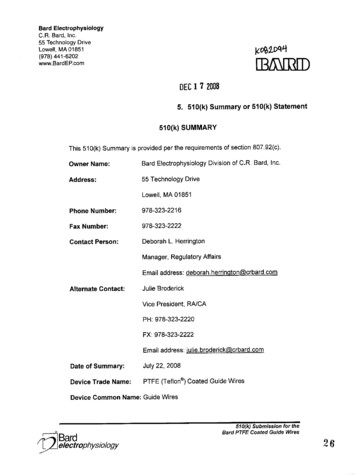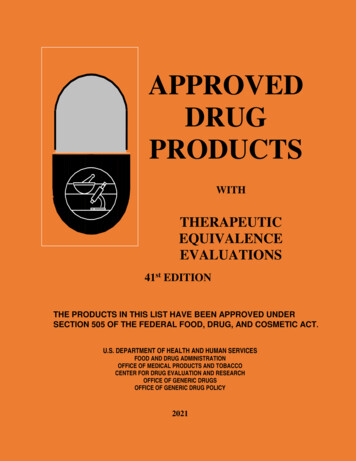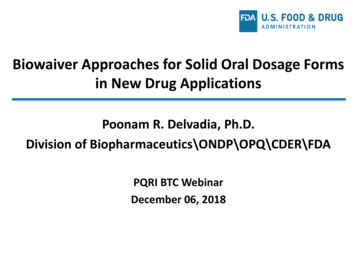
Transcription
Bard ElectrophysiologyC.R. Bard, Inc.55 Technology DriveLowell, MA 01 851(978) 441-62023M awww. BardEP. comDEC 1 7 20085. 510(k) Summary or 510(k) Statement510(k) SUMMARYThis 510(k) Summary is provided per the requirements of section 807.92(c).Owner Name:Bard Electrophysiology Division of C.R. Bard, Inc.Address:55 Technology DriveLowell, MA 01851Phone Number:978-323-2216Fax Number:978-323-2222Contact Person:Deborah L. HerringtonManager, Regulatory AffairsEmail address: deborah.herrinqton(acrbard.comAlternate Contact:Julie BroderickVice President, RA/CAPH: 978-323-2220FX: 978-323-2222Email address: iulie.broderickcrbard.comDate of Summary:July 22, 2008Device Trade Name:PTFE (Teflon ) Coated Guide WiresDevice Common Name: Guide WiresBardelectrophysio/ogy510(k) Submission for theBard PTFE Coated Guide Wires26
Classification Name:Class II,Catheter, Guide Wire (21 CFR 870.1330,Product Code DQX)Predicate Device(s):Bard Preamendment Guide WiresBard (U.S.C.I.) TRC Stainless Steel Safety Spring GuidesK772021Bard (U.S.C.I.) TRC Teflon Coated Safety Spring GuidesK780438The Bard PTFE (Teflon ) Coated Guide Wires, covered under this 510(k) PremarketNotification are substantially equivalent, in terms of intended use, materials ofconstruction, technological characteristics, and principles of operation, to thepredicate devices for facilitating the delivery of other devices per the indications foruse included in this 510(k).Device Description: The Bard PTFE (Teflon") coated guide wires, subject of this510(k), like their predicate device counterparts, are manufactured from stainlesssteel wire, tin/silver solder, and PTFE (Teflon ) coating, or Benzalkonium Heparin(BH) coating applied over the PTFE (Teflon ) coating. The guide wire constructionconsists of a safety wire, a core wire, and a wound spring for flexibility. The featuresthat distinguish individual wires consist of the core type (fixed or moveable), astraight or "J" tip configuration, diameters, lengths, and coating types. Each guidewire is subsequently packaged, labeled, and sterilized.There is no change between the Bard PTFE (Teflon ) Coated Guide Wires, subjectof this 510(k), and their predicate device counterparts with respect to: materials ofconstruction, manufacturing, packaging, labeling, or sterilization. The only differenceis the suppliers process change relating to environmental concerns toperfluorooctanoic acid (PFOA), a substance used as a processing aid in themanufacture of Teflon . There is no change to the actual Teflon material itself.510(k) Submission for theBard PTFE Coated Guide Wires
Substantial Equivalence: The Bard PTFE (Teflon ) Coated Guide Wires, subject ofThere is nothis 510(k), are substantially equivalent to the predicate devices.change to the indications for use, no change to the principles of operation, nochange to the materials of construction (only a reduction in residual PFOA and achange to the surfactant of the PTFE coating, both of which are both burned offduring the furnace cure, and therefore, not part of the Bard finished guide wires), andtechnological characteristics of the guide wires support a determination of substantialequivalence.Technological Characteristics: The Bard PTFE (Teflon ) coated guide wires,subject of this 510(k), are substantially equivalent to the Predicate Devices. The onlydifference is the supplier's process change relating to environmental concerns toperfluorooctanoic acid (PFOA), a substance used as a processing aid in themanufacture of Teflon (consisting of a reduction in residual PFOA and a change tothe surfactant, both of which are both burned off during the furnace cure, andtherefore, not part of the Bard finished guide wires). As stated above, there is noTherefore, the technologicalchange to the actual Teflon material itself.characteristics of the guide wires subject of this 510(k), are the same as theirpredicate devices.The Bard process for applying and curing the PTFE coating remains unchanged.The performance specifications for the Bard guide wires, subject of this 510(k),remain the same as their Predicate Device counterparts.Intended Use of Device: See individual indications for use statements below.Device Name: Bard PTFE (Teflon ) Coated Guide WiresIndications for Use:Bard Guide Wires Indication: Bard PTFE Coated Guide Wires are indicated forpercutaneous entry of a guiding catheter into a vessel using standard percutaneousmethods (Seldinger's Technique). Generally, Guide Wires which are 100cm or longerare indicated for use with vascular catheters and balloon dilatation catheters inangiographic or interventional procedures. The guide wire may be inserted through an510(k) Submission for theBard PTFE Coated Guide Wires28
[18g] needle, introducer, or catheter. A guide wire with an outer diameter of .018" orsmaller may be used with open ended guide wires.Guide wires which are shorter than 100cm are generally indicated for non-vascular use.Guide wires with an outer diameter of .018" or smaller may be inserted into the targetorgan through a [22g] needle or an open-ended guide wire (60cm or shorter), Largerguide wires may be inserted through larger gauge needles or an introducer forplacement of dilators and/or drainage catheters.Principles of Operation: A guide wire may be pre-loaded into a catheter to facilitateatraumatic insertion into and advancement through a vein or artery, or for otherpercutaneous access. A guide wire may also be used at the site of initial introductioninto the vasculature through a needle.Test Data: The Bard PTFE (Teflon ) Coated Guide Wires were subjected to thefollowing testing:1. Biocompatibility Testing - The modified PTFE coating was anticipated to haveno effect on the biocompatibility profile of the final guide wires. However, toensure that these guide wires meet the current biocompatibility requirements,testing of the Bard PTFE (Teflon ) coated guide wires was performed accordingto the requirements of the International Standard ISO 10993, "BiologicalEvaluation of Medical Devices Part-I: Evaluation and Testing" and the FDAmodified testing matrix included in the ODE May 1, 1995 General ProgramMemorandum #G95-1. Testing categories included: cytotoxicity, sensitization,intracutaneous reactivity, acute systemic toxicity, hemocompatibility, andmaterial mediated pyrogen testing. The biocompatibility testing demonstratedthat the Bard guide wires with the modified PTFE (Teflon ) coating process arenontoxic and biocompatible.2. Inhibition/Enhancement Testing and Product Endotoxin Testing per the Gel ClotMethod was conducted on representative samples manufactured with the "new"(replacement Teflon material) coating and were found to be acceptable.3. The replacement Teflon Primer was inspected to the raw material (RM)specification, it was used to mix the Primer Spray, the Primer Spray was appliedto representative products to confirm acceptable processing over the applicable510(k) Submission for theBard PTFE Coated Guide Wires
range of processing conditions and product constructions, and inspection andtesting was conducted to demonstrate the coated products are acceptable.4, Testing was conducted with representative guide wire items to demonstrate thatthe replacement material works acceptably for its intended function over therange of applicable processing conditions and product constructions withrespect to the coating application itself and the appearance of the coating. Theparameters selected for bench testing where chosen based on their impact onthe coating process. As the parameters within the coating process portion of thedevice manufacture did not change (i.e., oven cure time and temperature), guidewire stiffness, tensile and torque are not affected. Testing consisted ofcomparing samples manufactured from the replacement coating to samplesmanufactured with the current coating and performing coefficient of friction(COF) testing pre and post lubricity testing. Coating durability was confirmed via"flex" and "fracture" testing.6. Inaddition to the inspections and testing outlined above, a USP Physiochemicalanalysis and a FTIR analysis was conducted to compare the current PTFE(Teflon ) coating (850-604) to the replacement PTFE (Teflon ) coating (850N604). The replacement material meets the requirements of the USPPhysiochemical analysis testing and the FTIR analysis indicates no discernabledifference in chemical identity of the proposed finished coating from the currentfinished coating.Applicability of Performance Standards: Bard has determined that no mandatoryperformance standards have been established for the devices under Section 514 ofthe Medical Device Amendments to the Federal Food, Drug, and Cosmetic Act or bysubsequent regulatory action. Bard has determined that there are no applicablevoluntary standards.510(k) Submission for theBard PTFE Coated Guide Wires,s)
Conclusion: The results of the testing outlined above, consisting of biocompatibility,inhibition/enhancement, and LAL testing; demonstrates that the Bard PTFE (Teflon')Coated Guide Wires manufactured with the replacement Teflon material are:--biologically safe,non-pyrogenic,have no inhibition or enhancement effects upon the lysate reaction, andhave no discernable difference in chemical identityAdditionally, evaluation of the coating application; inspection of the coated product;bench testing; and physiochemical and FTIR analysis demonstrates that the BardPTFE (Teflon ) Coated Guide Wires manufactured with the replacement Teflon 5material:--met the performance requirements with respect to the parameters that would beimpacted by the coating consisting of coefficient of friction pre and post lubricitytesting, andcoating durability as demonstrated through "flwex and "fracture" testing.Therefore, the replacement Teflon material used in the manufactured of the guideWires covered under this 510(k) is substantially equivalent to the Teflon materialused in the manufacture of the predicate devices. And, the Bard PTFE (Teflon )Coated Guide Wires manufactured with the replacement Teflon material, subject ofthis 510(k), are substantially equivalent to the predicate devices.510(k) Submission for theBard PTFE Coated Guide Wires1
DEPARTMENT OF HEALTH & HUMAN SERVICESPublic Health ServiceFood and Drug Administration9200 Corporate BoulevardRockville MD 20850Bard Electrophysiologyd/o Ms. Deborah L. HerringtonManager, Regulatory Affairs55 Technology DriveLowell, MA 0 1851Re:DEC 1 72008K082094Trade/Device Name: Bard PTFE (Teflon ) Coated Guide WiresCommon Name: Wire, Guide, CatheterRegulation Number: 21 CFR 870.1330Regulatory Class: 11Product Code: DQXDated: December 4, 2008Received: December 5, 2008Dear Ms. Herrington:We have reviewed your Section 5 10(k) premarket notification of intent to market the devicereferenced above and have determined the device is substantially equivalent (for the indicationsfor use stated in the enclosure) to legally marketed predicate devices marketed in interstatecommerce prior to May 28, 1976, the enactment date of the Medical Device Amendments, or todevices that have been reclassified in accordance with the provisions of the Federal Food, Drug,and Cosmetic Act (Act) that do not require approval of a premarket approval application (PMA).You may, therefore, market the device, subject to the general controls provisions of the Act. Thegeneral controls provisions of the Act include requirements for annual registration, listing ofdevices, good manufacturing practice, labeling, and prohibitions against misbranding andadulteration.If your device is classified (see above) into either class II (Special Controls) or class III (PMA), itmay be subject to such additional controls. Existing major regulations affecting your device canbe found in the-Code of Federal Regulations, Title 21, Parts 800 to 898. In addition, FDA maypublish further announcements concerning your device in the Federal Register.Please be advised that FDA' s issuance of a substantial equivalence determination does not meanthat FDA has made a determination that your device complies with other requirements of the Actor any Federal statutes and regulations administered by other Federal agencies. You mustcomply with all the Act's requirements, including, but not limited to: registration and listing (21CFR Part 807); labeling (21 CFR Part 801); good manufacturing practice requirements as set
Page 2 - Ms. Deborah L. Herringtonforth in the quality systems (QS) regulation (21 CFR Part 820); and if applicable, the electronicproduct radiation control provisions (Sections 531-542 of the Act); 21 CFR 1000-1050.This letter will allow you to begin marketing your device as described in your Section 510(k)premarket notification. The FDA finding of substantial equivalence of your device to a legallymarketed predicate device results in a classification for your device and thus, permits your deviceto proceed to the market.If you desire specific advice for your device on our labeling regulation (21 CFR Part 801), pleasecontact the Center for Devices and Radiological Health's (CDRH's) Office of Compliance at(240) 276-0120. Also, please note the regulation entitled, "Misbranding by reference topremarket notification" (21 CFR Part 807.97). For questions regarding postmarket surveillance,please contact CDRH's Office of Surveillance and Biometrics' (OSB's) Division of PostmarketSurveillance at 240-276-3474. For questions regarding the reporting of device adverse events(Medical Device Reporting (MDR)), please contact the Division of Surveillance Systems at 240276-3464. You may obtain other general information on your responsibilities under the Act fromthe Division of Small Manufacturers, International and Consumer Assistance at its toll-freenumber (800) 638-2041 or (240) 276-3150 or at its Internet dex.html.Sincerely yours,Bram D. Z ckerman, M.D.DirectorDivision of Cardiovascular DevicesOffice of Device EvaluationCenter for Devices andRadiological HealthEnclosure
4. Indications for Use StatementIndications for Use510(k) Number (if known):Device Name: Bard PTFE (Teflon ) Coated Guide WiresIndications for Use:Bard Guide Wires Indication: Bard PTFE Coated Guide Wires are indicated forpercutaneous entry of a guiding catheter into a vessel using standard percutaneousmethods (Seldinger's Technique). Generally, Guide Wires which are 100cm or longerare indicated for use with vascular catheters and balloon dilatation catheters inangiographic or interventional procedures. The guide wire may be inserted through an[18g] needle, introducer, or catheter. A guide wire with an outer diameter of .018" orsmaller may be used with open ended guide wires.Guide wires which are shorter than 100cm are generally indicated for non-vascular use.Guide wires with an outer diameter of .018" or smaller may be inserted into the targetorgan through a [22g] needle or an open-ended guide wire (60cm or shorter), Largerguide wires may be inserted through larger gauge needles or an introducer forplacement of dilators and/or drainage catheters.Contraindications: NonePrescription Use XOver-The-Counter Use(Part 21 CFR 801 Subpart D)AND/OR(21 CFR 801 Subpart C)(PLEASE DO NOT WRITE BELOW THIS LINE-CONTINUE ON ANOTHER PAGE IF NEEDED)c Di'VcG!,;CU1r5 10[KjDOVICes.umlr.510(k) Submission for theBard PTFE Coated Guide Wires
Bard Guide Wires Indication: Bard PTFE Coated Guide Wires are indicated for . [18g] needle, introducer, or catheter. A guide wire with an outer diameter of .018" or smaller may be used with open ended guide wires. Guide wires which are shorter than 100cm are generally indicated for non-vascular use. Guide wires with an outer diameter of .018 .











